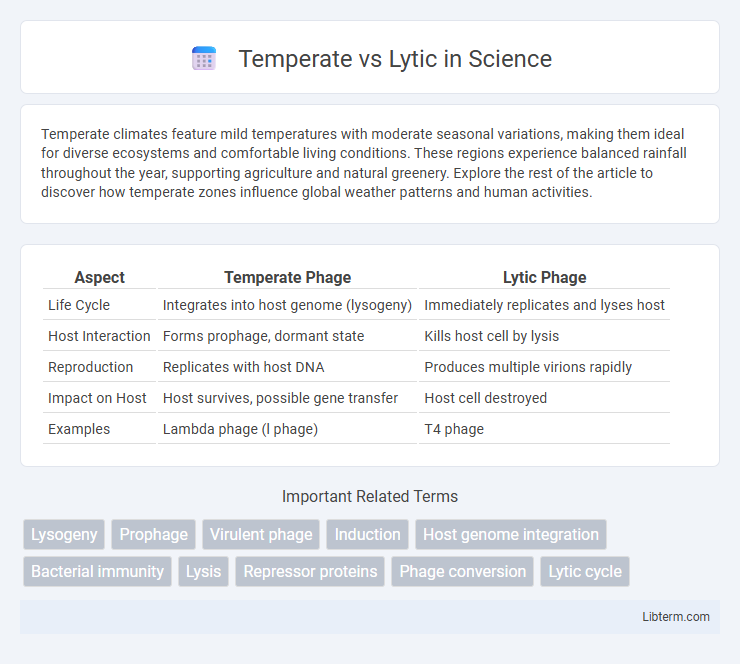Temperate climates feature mild temperatures with moderate seasonal variations, making them ideal for diverse ecosystems and comfortable living conditions. These regions experience balanced rainfall throughout the year, supporting agriculture and natural greenery. Explore the rest of the article to discover how temperate zones influence global weather patterns and human activities.
Table of Comparison
| Aspect | Temperate Phage | Lytic Phage |
|---|---|---|
| Life Cycle | Integrates into host genome (lysogeny) | Immediately replicates and lyses host |
| Host Interaction | Forms prophage, dormant state | Kills host cell by lysis |
| Reproduction | Replicates with host DNA | Produces multiple virions rapidly |
| Impact on Host | Host survives, possible gene transfer | Host cell destroyed |
| Examples | Lambda phage (l phage) | T4 phage |
Introduction to Viral Life Cycles
The viral life cycle includes two main types: temperate and lytic, each defining how viruses infect and replicate within host cells. Temperate viruses integrate their genetic material into the host genome, entering a latent phase called lysogeny, while lytic viruses immediately hijack the host machinery to produce new virions, causing cell lysis. Understanding the balance between these cycles is crucial for studying viral persistence, pathogenesis, and therapeutic strategies.
Overview of Temperate and Lytic Phages
Temperate phages integrate their genome into the host DNA, establishing lysogeny and replicating with the host without causing immediate lysis. Lytic phages, in contrast, hijack the host machinery to produce progeny virions rapidly, culminating in host cell lysis and phage release. The balance between lysogenic and lytic cycles influences phage ecology and bacterial population dynamics.
The Lytic Cycle: Key Mechanisms
The lytic cycle involves the injection of viral DNA into a host cell, followed by the hijacking of the host's cellular machinery to rapidly produce new viral particles. Key mechanisms include the replication of viral genomes, synthesis of viral proteins, assembly of new virions, and eventual lysis of the host cell to release progeny viruses. This process leads to immediate destruction of the host cell, enabling the virus to spread quickly to adjacent cells.
The Temperate Cycle: Lysogeny Explained
The temperate cycle in bacteriophages involves lysogeny, where the phage DNA integrates into the host bacterial genome and replicates passively without killing the host cell. This lysogenic state allows the phage genome, called a prophage, to be stably maintained and passed to daughter cells during bacterial cell division. Environmental triggers can induce the prophage to exit lysogeny, enter the lytic cycle, and produce new phage particles, leading to host cell lysis and phage release.
Genetic Regulation in Phage Cycles
Temperate phages regulate their genetic switch between lysogenic and lytic cycles through the interplay of repressor proteins like CI and Cro, which bind operator sites to control transcription of phage genes. In the lysogenic pathway, the CI repressor maintains prophage dormancy by inhibiting lytic gene expression, whereas in the lytic cycle, Cro promotes the expression of genes required for phage replication and host cell lysis. This genetic regulation involves feedback loops and environmental signals that influence the balance between maintaining lysogeny and initiating the lytic phase.
Environmental Triggers of Cycle Selection
Temperate phage lifecycle decisions are influenced by environmental cues such as nutrient availability, host cell stress, and population density, prompting integration into the host genome under favorable conditions. Lytic cycle selection often occurs in environments rich in nutrients, where rapid host cell replication supports phage propagation and leads to immediate lysis. Factors like UV radiation, DNA damage, and oxidative stress can trigger temperate phages to switch from lysogenic to lytic cycles, ensuring survival through host cell destruction.
Impact on Host Bacteria
Temperate phages integrate their genome into the host bacterium's DNA, allowing the host to survive and replicate with the viral DNA passively maintained, which can lead to lysogenic conversion and increased bacterial fitness or virulence. Lytic phages hijack the host's cellular machinery to produce progeny virions, resulting in the destruction of the bacterial cell through lysis and immediate reduction of the bacterial population. The choice between temperate and lytic cycles significantly influences bacterial survival, adaptation, and the dynamics of microbial communities.
Evolutionary Advantages of Each Strategy
Temperate phages integrate their genome into the host DNA, allowing long-term survival and horizontal gene transfer, which enhances bacterial diversity and adaptability. Lytic phages rapidly replicate and lyse the host cell, promoting swift population expansion and strong selective pressure on bacterial resistance. These contrasting evolutionary strategies balance dormancy and aggression, optimizing viral persistence and spread in fluctuating environments.
Applications in Biotechnology and Medicine
Temperate phages enable lysogeny, allowing genetic material integration into bacterial genomes, which is essential for developing gene delivery systems and bacterial genome editing tools in biotechnology. Lytic phages facilitate rapid bacterial cell lysis, making them valuable in phage therapy for targeting antibiotic-resistant bacterial infections and in biocontrol applications to reduce pathogenic bacteria in agriculture and food safety. The choice between temperate and lytic phages depends on desired outcomes, with temperate phages used for stable genetic modification and lytic phages for immediate bacterial eradication.
Summary: Comparing Temperate vs Lytic
Temperate and lytic phages differ primarily in their replication strategies: temperate phages integrate their genome into the host DNA, entering a lysogenic cycle that allows dormancy and replication with the host, whereas lytic phages hijack the host machinery to produce new virions, culminating in host cell lysis. Temperate phages offer genetic diversity and evolutionary advantages through lysogeny, while lytic phages ensure rapid replication and immediate destruction of bacterial cells. Understanding these distinct viral life cycles is crucial for applications in phage therapy, bacterial genetics, and biotechnology.
Temperate Infographic

 libterm.com
libterm.com